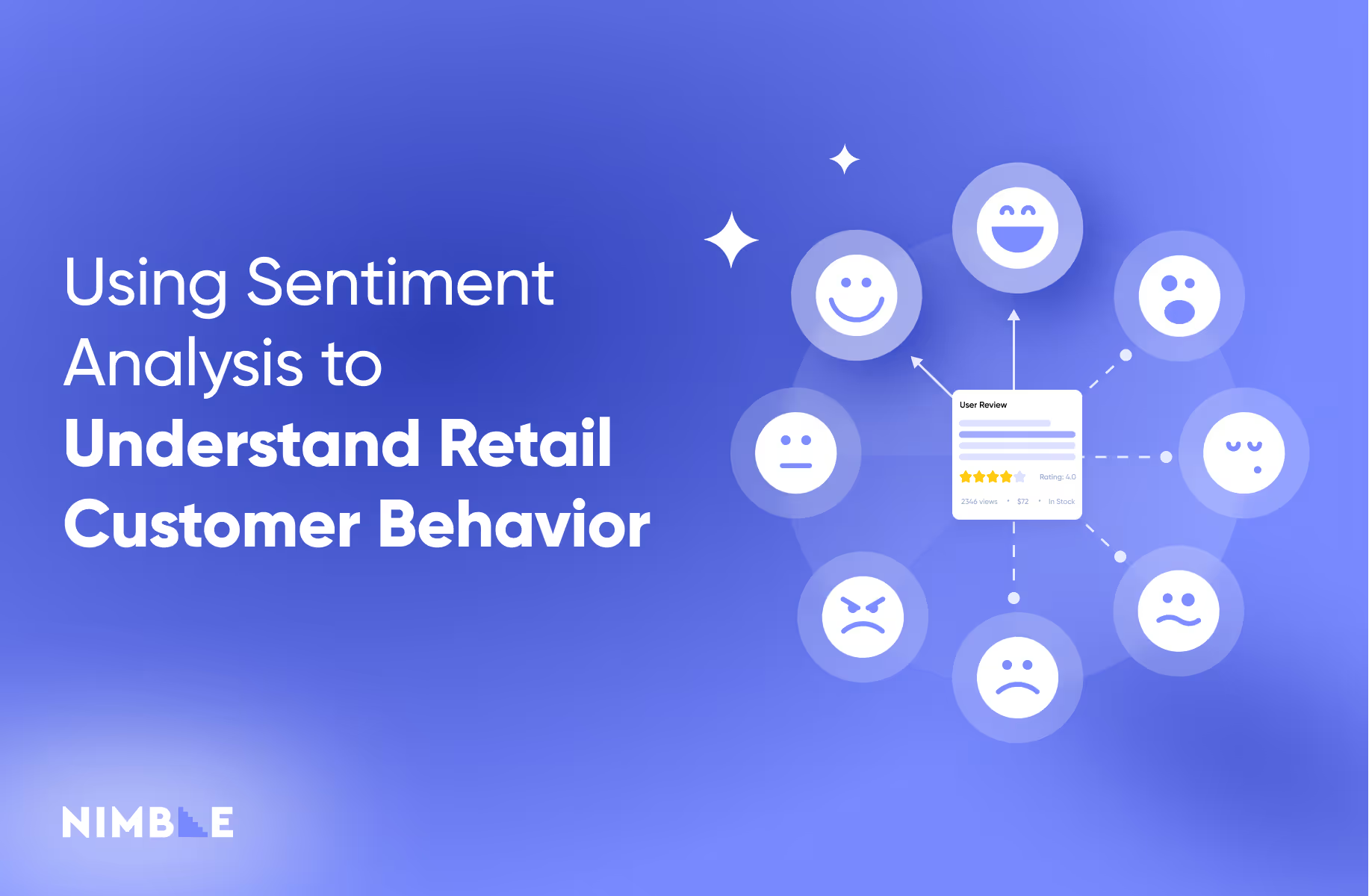How SERP Data for E-Commerce Informs Stronger Cross-Sell Strategy

.avif)
Use real-time search behavior to uncover product pairings, optimize bundles, and boost average order value across your digital shelf.
Search results are more than just a digital leaderboard: they’re a window into e-commerce search behavior. Every query, listing, and co-ranked product offers clues about what consumers want to buy. The smartest e-commerce merchandising teams are using this real-time behavioral data to inform their cross-sell strategy, build more effective product bundling, and drive measurable gains in average order value (AOV).
This blog explores how SERP data for e-commerce reveals high-value product associations, and how tools like Nimble make these insights accessible and actionable for your digital shelf strategy.
Key Takeaways
- E-commerce search behavior reveals bundling opportunities that traditional CRM or sales data often miss.
- SERP data shows real-time product pairings based on how consumers actually search—not just what they’ve bought.
- Nimble surfaces and tracks these signals at scale, helping you create cross-sell campaigns that feel intuitive to the shopper and drive AOV growth.
- Winning cross-sell strategies starts with the SERP, and ends with smarter merchandising, better bundles, and a stronger digital shelf strategy.
Why SERP Data Is the Missing Piece in Cross-Sell Strategy
Most cross-sell strategies rely on what’s already happened: historical purchase behavior, CRM records, or basic “people who bought X also bought Y” logic. While that data can be helpful, it’s also backward-looking. It tells you what was bought, not what’s being searched for right now.
To answer that question, you need SERP data.
Purchase History ≠ Search Intent
Purchase-based recommendations reflect post-decision behavior, after the shopper has already narrowed their focus. They miss the discovery phase, where intent is still fluid and shoppers are open to influence. Worse, they’re limited by your own customer base. That biases your insights are toward past buyers, not emerging trends.
SERP Patterns Surface Real-Time Associations
When products co-appear in search results (organic listings, ads, Shopping carousels), it reveals how the market, not just your customers, thinks about those items. These associations reflect current demand signals, evolving interests, and competitor experimentation.
Importantly, they’re not locked into your data silo. Instead, they reflect the broader digital shelf across retailers, categories, and search behaviors.
Why This Matters for Cross-Sell Strategy
- Nimble’s SERP analytics give you a live window into shopper intent before the transaction, while preferences are still forming.
- By acting on real-time co-search trends, you can get ahead of purchase patterns instead of reacting to them.
- That means suggesting smarter bundles, launching more relevant campaigns, and capturing demand before competitors even notice the shift.
With the right e-commerce solution, ecommerce teams move from hindsight to foresight, turning SERP signals into competitive advantage.
3 SERP Signals in E-Commerce Search Behavior That Reveal Cross-Sell Potential
Understanding shopper intent is the key to smarter cross-sell strategy. Thankfully, the search engine results page (SERP) is full of clues. By analyzing how products appear together in real-world search results, e-commerce merchandising teams can uncover high-potential product pairings that go far beyond guesswork or legacy CRM data. Here are three of the most powerful SERP signals to watch:
1. Co-Ranking Products in the Same Query
When two products consistently show up in the same set of search results, that’s not a coincidence. Google’s algorithm surfaces products based on search intent, relevance, and user behavior, so if “running shoes” and “compression socks” keep appearing together, there’s likely a natural buyer association between them.
Nimble captures these co-ranking patterns across thousands of ecommerce queries, helping retailers identify which items consumers already associate with each other before a purchase even happens. That’s gold for bundling strategy. Instead of asking “What else might they want?”, you’re answering “What else are they already searching for?”
2. “Frequently Bought With” Schema and SERP Overlap
Marketplace SERPs often display dynamic pairings like “Frequently Bought Together” or “Customers Also Bought.” These are merchandising signals backed by real purchase behavior.
What’s powerful is when these schema-based suggestions overlap with organic or paid placements in the main SERP. If a product repeatedly shows up next to another in both places, it’s a strong indicator of complementary value. Nimble tracks this overlap across major retailers and marketplaces, surfacing pairings your team can act on fast. Think of it as real-time market validation for your next cross-sell campaign.
3. Competitor Bundling Patterns and Rankings
Your competitors are already testing bundles, and the SERP shows what’s working. Are they grouping items into value packs? Are those bundles ranking higher than your standalone product pages?
Nimble for e-commerce identifies which brands are bundling what, how those bundles are positioned in search results, and which ones are rising to the top. This gives ecommerce teams a data-backed view of emerging bundling strategies, as well as the gaps where your brand can outmaneuver them.
How to Take Action: Merchandising + Campaign Ideas
Once you’ve uncovered high-potential product pairings through SERP signals, the next step is activating them across your ecommerce strategy. Here’s how top brands are using Nimble insights to drive real-world results across merchandising, content, and campaigns.
%20(1).avif)
Product Bundling Based on Co-Search Data
Use co-ranking data as the foundation for smarter, search-aligned product bundles.
- Bundle SKUs that co-appear in high-intent queries (e.g., “home espresso machine” + “milk frother”) to mirror how shoppers are already thinking.
- Use heatmap data to prioritize bundles by query volume, frequency of co-occurrence, and competitor gap (e.g., popular pairings not yet bundled in your category).
- A/B test bundles by placement and format: side-cart suggestions, “complete the set” modules, or single-SKU bundles with a discounted price.
- Leverage schema markup for “hasPart” and “isAccessoryOrSparePartFor” to improve how bundled listings surface in SERPs and Shopping results.
When bundles align with how people search, they convert better—and rank better.
Custom Landing Pages That Match Search-Intent Pairs
Build landing pages that mirror specific co-search patterns and seasonal demand spikes.
- Group co-ranked products into themed landing pages tied to real queries (e.g., “summer grilling essentials” leads to a combination of grill + marinade tray + thermometer).
- Use query-level SERP analysis to map keyword clusters to each page and guide both copy and metadata.
- Embed marketplace-friendly markup and structured data to qualify for Shopping ads and organic enhancements.
- Track performance using Nimble’s SERP monitoring to see how the page ranks over time, and how competitors respond.
These intent-driven bundles have a much higher chance of converting. They also compound SEO value by reflecting real shopper behavior.
Email Campaigns Based on Trending SERP Behavior
Real-time co-ranking trends don’t just help your on-site experience—they can drive engagement across channels.
- Trigger emails based on emerging product pair signals, e.g., “Customers searching for [primary product] are also viewing [secondary product].”
- Incorporate SERP-based urgency into campaign copy, e.g., “This combo is trending this week across Amazon and Google Shopping.”
- Segment audiences based on recent purchase or browse history, then match them with trending co-searched add-ons or bundle upsells.
- Use Nimble’s trend alerts to automate campaign inputs or generate new bundle ideas every week.
SERP-driven merchandising isn’t limited to your PDPs. Done right, it fuels full-funnel lifecycle marketing.
Conclusion: Turn Shopper Intent Into Smarter Cross-Sells
SERP data doesn’t lie. It shows you exactly how customers think, search, and associate products before they buy. The most effective cross-sell strategies aren’t built on assumptions or legacy purchase data. They’re powered by real-time insights pulled straight from the digital shelf.
Nimble makes those insights actionable. By surfacing product pairings, co-ranking patterns, and marketplace bundling trends, Nimble equips e-commerce teams to create better bundles, and launch more relevant campaigns. Instead of chasing transactions, Nimble helps you shape a smarter, search-informed digital shelf strategy that grows with your customers.
Contact our team to discover how Nimble can uncover cross-sell opportunities hiding in plain sight.
FAQ
Answers to frequently asked questions











